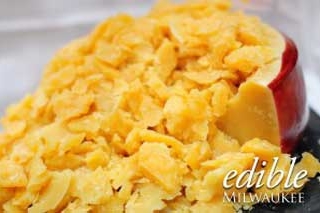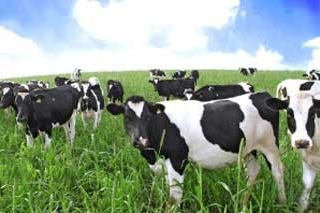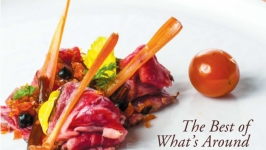Changing Times for Wisconsin Cheesemakers
GMO labeling coming up next at Whole Foods cheese counters
Organic. Fair Trade. Grassfed. Certified Naturally Grown. Animal Welfare Approved.
American Humane Certified. You’ve seen these labels on hundreds of products in your local grocery aisle, signifying whatever box, can, or carton you’re about to purchase is certifiably grown or processed as described.
Well, brace yourself. There’s a new label in town, and this one has the potential to change the way a significant number of American farmers grow corn, soybeans and alfalfa—foods eaten by nearly every animal that ends up on our dinner plates and produces the milk we pour on cereal and eat in cheese. The Non-GMO Project Verified seal, a rectangular label with two spears of grass and an orange butterfly, is about to appear much more in your grocery aisle. Why? Two words: Whole Foods.
With more than 400 stores in the United States and Canada, and annual sales of $14.2 billion, Whole Foods is a major player in the North American natural food market. Last year, the company announced that by 2018, all products in its U.S. and Canadian stores must be labeled if they contain genetically modified organisms, known as GMOs. Whole Foods is the first national grocery chain to set a deadline for full GMO transparency. Its GMO labeling will go further than any current state law or pending national initiative for labeling.
“This is about providing transparency to consumers,” says Cathy Strange, global cheese buyer and national procurement & distribution officer for Whole Foods Inc. “Our quality standards for food already prohibit the use of artificial colorings, flavorings, preservatives, hydrogenated oils and high fructose corn syrup. This is just taking it to a higher level.”
What is a GMO?
To GMO or not to GMO, that seems to be the question. But what is a GMO, anyway?
Simply put, it is an organism that has DNA, or genetic make-up, that does not occur in nature. Most of the time, GMO crops are genetically engineered to survive herbicides or resist disease. But often, they are developed to serve customer demand. One of the first GMO-foods to hit the U.S. market was in 1994, when American shoppers and grocers alike whole-heartedly embraced the Flavr Savr Tomato. The fruit had been genetically engineered for delayed-ripening and boasted a longer shelf life than conventional tomatoes.
In 1997, on the heels of global questions about the safety of genetically altered food, the European Union declared mandatory labeling on all GMO food products, including animal feed. The U.S. did not follow suit. By 1999, more than 100 million acres worldwide were planted with genetically engineered seeds, and the American marketplace began fully embracing GMO technology. Today, at least 88 percent of all corn, sugar beets, soybeans, canola and cotton in North America are GMO-grown, according to the United States Department of Agriculture, and more than 70 percent of all packaged foods contain GMOs.
In addition, more GMO-fruits are beginning to enter the American marketplace. Just this spring, the USDA announced its decision to “deregulate” two apple varieties genetically engineered to resist browning. This is the first step in the federal government’s food safety assessment of GMO foods. If all goes to plan for Okanagan Specialty Fruits, a biotechnology company in Summerland, British Columbia, the company’s apples, known as Artic Granny and Artic Golden, could soon be on U.S. store shelves, and your kids could have the chance to never eat a cut apple turned brown again.
Despite these massive strides in genetically modified food technology, American consumer reaction to GMO products may be changing. A recent poll by The Huffington Post in partnership with YouGov found 82 percent of Americans want labels for GMO food, and two states on opposite coasts—California and Vermont—have pursued GMO labeling. The California initiative was defeated at the polls last fall, while a federal judge is weighing whether to halt Vermont’s first-in-the-nation GMO labeling law, passed last May, but now mired in a lawsuit filed by The Grocery Manufacturers Association.
GMOs in Cheese
In Wisconsin, the 2018 labeling mandate handed down by Whole Foods has gotten the attention of one of the state’s signature industries: cheese. Dozens of the state’s cheese companies—big and small—sell cheese to Whole Foods, which is, without question, the largest specialty cheese retailer in the United States. If these companies don’t want Wisconsin cheese labeled as a GMO product by one of their biggest retail customers, they must find alternatives to two important cheese inputs: feed that cows eat to produce milk, and rennet used to turn that milk into curds and whey.
Neither input is simple to make 100 percent GMO-free, and both take significant time to study and solve, says Katie Fuhrmann, cheesemaker at LaClare Farms. Fuhrmann is the 2011 U.S. Champion Cheesemaker for her farm’s Evalon, a farmstead gouda-style goat cheese sold across the country at Whole Foods stores. She, her parents, Larry and Clara Hedrich, and an array of siblings and family members, milk 400 goats year-round near Malone. The milk is crafted into an array of products, including bottled milk, caramel and cheese.
Fuhrmann says the feed ration fed to LaClare Farms’ goats is almost all non-GMO, and the farm is working to guarantee all non-GMO feed sources for the future. This takes considerable effort, because about the only option to raising non-GMO animal feed in America today is by becoming certified organic. Organic feed is expensive, which in turns makes the cost of producing milk expensive, which, in turn, leads to higher priced cheese.
“We are in the process of figuring out how we can guarantee our feed supply is non-GMO at an affordable price,” Fuhrmann says. “We know it can’t be changed overnight. But the more we know, the better we can educate our team and the group of farmers we work with.”
Fuhrmann’s attitude is exactly what Whole Foods’ Cathy Strange is encouraging in cheesemakers. Strange knows that non-GMO certification in cheese will not happen quickly, because according to the standards set by The Non-GMO Project, dairy animals must be fed non-GMO feed for at least one full year prior to becoming verified.
“Our goal is to work with farmers and cheesemakers to get them moving in the direction of non-GMO products,” Strange says. “We have people on our team who have been personally meeting with cheesemakers in Vermont, Wisconsin and California to work with them not just on the feed, but on the feed mills being used to mix rations for animals. Many of these feed mills are mixing rations for dozens of farmers, and the non-GMO feed can not be mixed with conventional feed.”
GMO-Free Rennet
While Whole Foods’ current focus for non-GMO cheese is on the stuff dairy animals eat, a second tier of verification may loom in the future, focusing on the rennet used to make cheese. And this is where it gets a bit complicated. Because while genetically modified corn, soybeans and other crops have gotten the limelight in the non-GMO debate during the past decade, a lesser-known application of biotechnology in cheesemaking has resulted in 90 percent of all American cheeses today being made with GMO microbial rennet.
What is rennet? Well, rennet is absolutely key to cheesemaking, as it functions as a coagulant to clot milk into cheese curd. The primary enzyme in rennet is called chymosin. Traditionally, rennet was obtained from the fourth stomach lining of a young calf (veal rennet). In the 1960s and 1970s, the veal industry began to decline with pressure from the animal rights movement. But at the same time, the cheese industry began to grow. With less supply and more demand, the price of rennet skyrocketed. Companies began looking for a substitute.
In the 1980s, scientists discovered a way to transfer a single gene from bovine cells into microbes, giving microbes the ability to produce chymosin. These genetically modified microbes were multiplied and cultivated. Thus, microbial rennet was born. Known as fermentation-produced-chymosin, or FPC, it was approved by the Food and Drug Administration in 1990. Today, the majority of American cheesemakers use FPC microbial rennet. While its use is banned in the European Union for cheeses consumed in Europe, many European cheesemakers use it in cheese made for export to North America, as it is cheaper and more consistently available than veal rennet or non-GMO microbial rennet.
Bob Wills, master cheesemaker and owner of Clock Shadow Creamery in Milwaukee and Cedar Grove Cheese in Plain, is well versed in the difference between non-GMO rennet and FPC microbial rennet. Wills has long been on the forefront of food transparency. In 1993, Cedar Grove Cheese became the first company in the nation to require its dairy farmers to not use Recombinant Bovine Growth Hormone, or rBGH, a synthetic hormone traditionally used by some farmers to increase milk production. Wills was the first to label his cheese rBGH-free, which is today a common label on specialty cheeses.
In January 2001—long before most Americans even knew what GMO meant—Cedar Grove Cheese decided all its cheese should be made exclusively with non-genetically modified organisms. Wills carefully selects the company’s starter cultures and enzymes, using microbial rennet made from species not created by gene transfer technology.
“We are able, and do, receive verification from the suppliers of microbial enzymes that their products do not contain and are not produced using genetically engineered organisms,” Wills says. “We think it is important that customers be accurately informed on that point.”
If and when Whole Foods or other retailers do require cheesemakers to prove they are using non-GMO rennet to avoid GMO labeling, Wills will be ahead of the curve. “Currently our direction on non-GMO is around feed and not focused on rennet and cultures. That may change at some point in the future,” Strange said.
Non-GMO Certification
Currently, the only non-GMO certifier with which Whole Foods works is a non-profit organization called The Non-GMO Project. That’s because it is the only third-party labeling program in North America for products grown without using genetic engineering. The Non-GMO Project, and its butterfly-perching “Verified” seal are the only option for companies that want to verify that the process their products go through, from seed to shelf, are produced according to the non-profit’s rigorous best practices for GMO avoidance. “They are pretty black and white,” Strange says.
Cheesemakers and other food producers wishing to pursue non-GMO status would do well to peruse The Non-GMO Project’s “Standard,” a 37-page list of every “input” category possible—from commercially purchased feed to onsite farm and feed mill inspections to quality assurance and labeling. The non-profit organization is working hand-in-hand with retailers such as Whole Foods to grow its list of non-GMO food processors.
“Our bottom line is we want food to be transparent,” Strange says. “Will we kick out non-GMO products from our stores? Of course not. But we do think customers will make the choice to not consume GMO products once they are labeled. And as we all know, the customer ultimately has the last word.”
To read the complete standards set by The Non-GMO Project and to learn more about certifying ingredients, visit www.nongmoproject.org.








